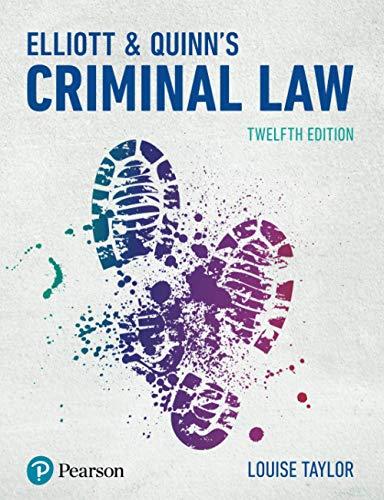Question
LANDMARK CASE Salomon v Salomon Ltd , [1897] AC 22 (HL) THE HISTORICAL CONTEXT: When Salomon was decided, the corporate form was just coming into
LANDMARK CASE
Salomon v Salomon Ltd, [1897] AC 22 (HL)
THE HISTORICAL CONTEXT: When Salomon was decided, the corporate form was just coming into wider usage. At the time, it was unclear whether companies with few shareholders would be recognized as separate legal entities.
FACTUAL BACKGROUND: Aron Salomon carried on a profitable shoe-manufacturing business for many years as a sole proprietor. He decided to form an incorporated companyAron Salomon and Company, Limitedas the vehicle through which to run his business. The Companies Act, which set out the rules for creating a company, required that a company have a minimum of seven shareholders. Therefore, Aron took one share and members of his family took the remaining six shares.
Aron became the managing director. Practically speaking, Aron Salomon and Company, Limited, was a "one-person company", since Aron entirely controlled the company. Put another way, the other participants in the company had no involvement in operations: any decision the company took was only because Aron wanted it to follow that particular course of action.
Next, Aron Salomon and Company, Limited, agreed to purchase the assets of Aron's sole proprietorship. As the corporation had little cash, Aron was issued 20 000 shares and a mortgage secured by the shoe-business assets. In this way, Aron became a highly protected creditor of his own company.
The business suffered financial problems due to a series of strikes and the loss of government contracts. The company became insolvent, and a trustee was appointed to deal with its creditors and close down the business. Many creditors of Aron Salomon and Company, Limited, lined up for payment, but there were insufficient assets to satisfy them. In response, the trustee in bankruptcy took the position that Aron was personally responsible for all his company's debts.
THE LEGAL QUESTION: Was Aron liable for the debts of Aron Salomon and Company, Limited? Was Aron a legitimate creditor of the company?
RESOLUTION: A corporationlarge or smallis a separate legal entity and, as such, is totally responsible for its own obligations. Indeed, one of the main reasons for creating a company is to limit liability in the event of bankruptcy. The court rejected the argument that there was something essentially improper about an individual conducting his business through a one-person corporation to secure the protection of limited liability. If a number of persons can limit their liability in this way, then why shouldn't a single person be able to do the same thing? After all, it should not make any difference to a creditor whether one or several shareholders limit their liability.
The House of Lords also confirmed that there is nothing wrong with a shareholder being a creditor of the corporation, even when that shareholder essentially controls the company in question. Furthermore, the creditors had chosen to deal with Aron's companynot with Aron, the individualand had chosen to do so on an unsecured basis. They, in turn, would have to live with the adverse outcome of that business decision.
Do you think that the court went too far in giving independent existence to the corporation, especially when the interests of Aron and his company were virtually identical? Should the shareholder of a one-person company be entitled to limited liability? How could the creditors, other than Aron, have better protected themselves in this situation?
Step by Step Solution
There are 3 Steps involved in it
Step: 1

Get Instant Access to Expert-Tailored Solutions
See step-by-step solutions with expert insights and AI powered tools for academic success
Step: 2

Step: 3

Ace Your Homework with AI
Get the answers you need in no time with our AI-driven, step-by-step assistance
Get Started


